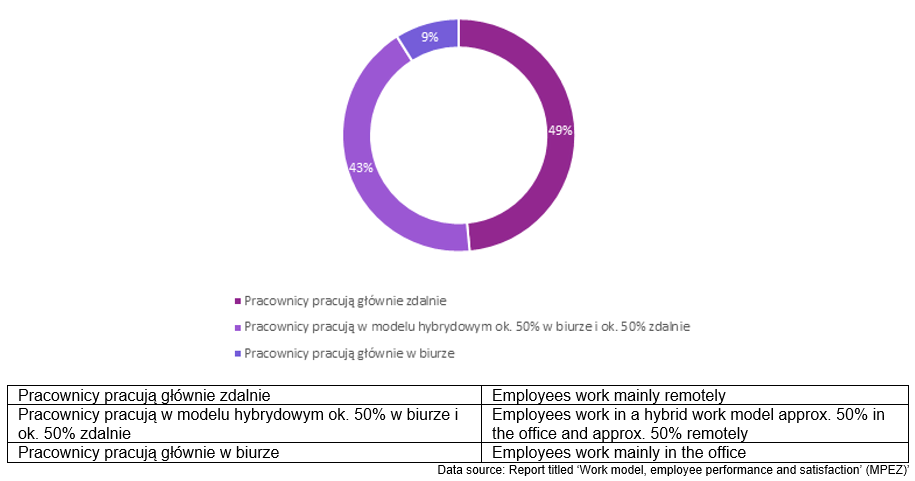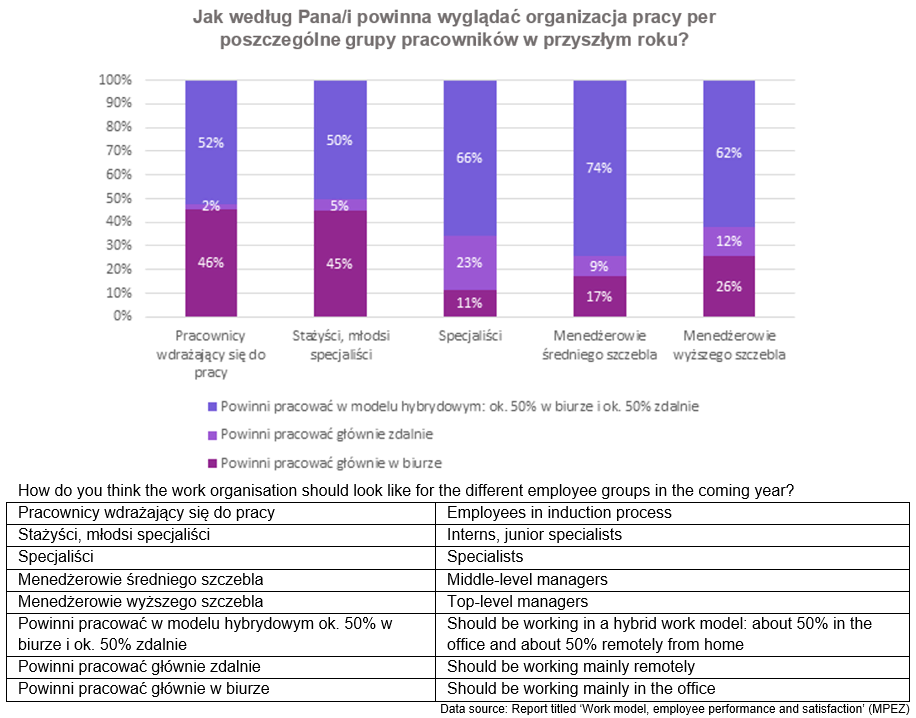Remote, hybrid or in-office work model? What will companies choose in 2021?
Table of contents
Work efficiency is rated at its highest by employers, when duties are performed remotely (92%), followed by in-office work model (89%). The hybrid work model received less positive feedback – however just 7% less than the previous one. As the year 2021 kicks off, board members are asking themselves the following question: which work organisation model will be the best option for their companies? Will new work environment require additional changes? Antal, together with Corees Polska commercial real estate agency, have prepared an answer to these, and other questions in a report titled ‘Work model, employee performance and satisfaction’ published today.
Work in remote mode as of now – what changes does it require?

As many as 49% of surveyed employees worked remotely in recent months. Those who worked within hybrid work model, i.e. 50% in an office and 50% remotely, accounted for 43%. Only 9% of employees performed their duties in the office. Like never before, the time of the pandemic allowed companies to review different work organisation models and adapt in advance to the dominant online mode. To do so, the technical infrastructure had to be modified, but so did data security. 52% of companies declare that they had to introduce new procedures in this area and update their systems.
What employers value most in remote work model is work efficiency (92% of them rated this aspect positively). Other aspects which were rated well, are limited business travel expenses (81%) and maintained salary levels (71%). In contrast, 35% of respondents speak negatively about integration and collaboration. What is more, employees’ recruitment seemed to be a problematic issue faced by organisations in the remote reality – it was rated negatively by 16% of respondents. The situation is similar in the case of new employee onboarding, rated negatively by 29% of respondents.
With the remote work model becoming ubiquitous, employers have had to update their infrastructure and equipment in a very short period of time. Many companies were forced to make technological upgrades. The surge for demand for hardware caused shortages in distributors’ warehouses. It took two months for new hardware to be delivered, which delayed new employees’ onboarding for some companies. – says Fabian Pietras, Business Unit Director at Antal IT Services.
Will the hybrid work model stay with us for longer?
From the employees’ perspective, the hybrid work model has the following advantages: communication with team members (83% of positive opinions), no need to commute (82% of positive opinions). Communication with supervisors, workplace ergonomics and job satisfaction are also ranked high. As with a fully remote work model, challenges include integration and collaboration (40% of negative opinions), as well as new employees’ onboarding (31% of negative opinions). Recruitment, however, ranks better – assuming a partial office presence model, it is easier to schedule face to face meetings.
When considering future actions, companies should analyse individual work models in terms of the factors that are most important to them. While implementing a particular work model, it is worth to pay a special attention to the areas which pose the most significant threat to the functioning of the business. Employees’ turnover received the most negative evaluations in case of a traditional office work model (more than 23% of less positive responses than in case of other work models). Also employees’ satisfaction is often rated negatively by employers. This is directly related to employees’ preference for hybrid work model and treating the possibility of remote work as a beneficial, but also already common and standard additional benefit. – points out Artur Skiba, CEO at Antal Poland.
What will companies choose in 2021?
Employers declare that although the hybrid work model is not an ideal solution, it will still be in place in their companies in 2021 (77%). Groups of people that are required to have a greater presence in the office include newcomers to the organisation, interns and junior specialists, as well as front-office employees. This will also change the role of the office space as the company’s flagship in the eyes of future employees and clients, and in the same time, as a place supporting the onboarding and integration of new employees. The quality of equipment, office design and convenient location will be important to facilitate recruitment and maintain business contacts.

The satisfaction with remote or hybrid work model shown by employers and the intention to maintain such a model in the next year is not surprising, if we consider the benefits resulting out of such. First and foremost, it is the reduction of maintenance costs of the company, while exposing high efficiency by employees, which was the main concern at the beginning of the pandemic. Yet, it all depends on the industry in which the company operates, as well as the positions of individual employees within the company structure. Employers are already looking for new solutions to be applied within welcoming newcomers to the organisation, and in the same time to be exercised by interns, junior specialists and front-office workers. – comments Marek Ciunowicz, CEO at Corees Polska. The employer will therefore need to improve solutions in both work models to meet staff expectations while maintaining company’s efficiency and exercising control over employees, which, from the employers’ perspective, is easier in the case of office work. The unanswered question is the form of the contract and the space in which the companies will continue their activities – he adds.
About the report: The report titled ‘Work model, employee performance and satisfaction’ (MPEZ) aims to answer these questions by aggregating the experiences of several hundred employers and employees. In the report, we show which aspects of work (whether remote or in-office) are rated as effective, which aspects arouse employee satisfaction, and which aspects pose potential threats to the organisation, such as increased employee turnover or inefficient internal communication. You can download the report here.
About the Survey: The survey was carried out in December 2020 among 315 employers, using the CAWI method The survey carried out among 956 employees (specialists and managers) was conducted in December 2020, using the CAWI method.
The report has been made in cooperation with the Corees Polska commercial real estate agency. www.corees.pl















